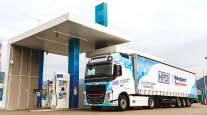Westport to End 15-Liter LNG Engine, Citing High Cost of Building Power Plant
This story appears in the Nov. 11 print edition of Transport Topics.
Westport Innovations announced it is discontinuing its 15-liter liquefied natural gas engine, a move that will leave the North American trucking market without a natural-gas option for applications requiring high horsepower.
The company said Nov. 15 will be the final day for customers to order its HD15 compression engine, which uses both diesel fuel and LNG.
Westport said about 1,000 of these engines have been sold since hitting the market in 2007. They have been available in Paccar Inc.’s Kenworth and Peterbilt brand trucks.
“It’s an expensive, hand-built product,” said Gordon Exel, Westport’s vice president of sales and marketing. “It was doing the job, but we couldn’t get the volume and economies of scale to bring the costs down.”
The cost of a truck equipped with that Westport engine typically has been $80,000 to $90,000 more than the same model with a diesel engine, said Bob Fry, a sales manager at Inland Kenworth’s dealer locations in Southern California.
Trevor Fridfinnson, senior vice president at Bison Transport, said his company was “a little bit surprised at the timing” when it first heard that Westport was looking to discontinue the HD15, considering that there isn’t yet another high-horsepower natural-gas engine on the market.
About a year ago, the Winnipeg, Manitoba-based truckload carrier purchased 15 Peterbilt trucks with the Westport engine, which it uses in heavy-haul applications such as pulling twin 53-foot trailers in Alberta, Canada, he said. To do that, Bison needs the horsepower of the 15-liter engine.
Westport recently said it planned to continue offering the engine as long as there was demand for it, but it now has reversed that stance.
With the departure of the HD15, fleets now have only two engine choices for natural-gas trucks, both spark-ignited engines produced by Cummins Westport, Westport’s joint venture with engine maker Cummins Inc.
Cummins Westport has been selling its 9-liter ISL G for several years and this year launched the 12-liter ISX12 G.
The 12-liter model offers ratings up to 400 horsepower and 1,450 pound-feet of torque, but that can’t match the maximum 475 hp and 1,750 pound-feet ratings for the HD15.
Exel said the ISX12 G is restricted to 80,000-pound gross vehicle weight.
“We didn’t have that limit on the HD15, so when you really look at this, the gap that’s been created is anything that’s over 80,000 GVW,” he said.
In the years ahead, though, future natural-gas product offerings could fill that gap.
Last year, Volvo Trucks announced plans to launch a proprietary 13-liter natural-gas engine with Westport’s high-pressure, direct-injection technology. The company recently said it expects that engine, the D13-LNG, to hit the market in 2015.
Meanwhile, Cummins is developing a 15-liter spark-ignited natural-gas engine, the ISX15 G, outside its joint venture with Westport. The company said it is on track to launch that product in early 2016.
Bison’s Fridfinnson said the fleet is interested in the next generation of high-horsepower natural-gas options.
“We didn’t go down this path and put the time and energy into it just to run 15 trucks,” he said. “We think there’s a potential viable future here.”
Westport said it is shifting its strategy toward vertically integrating its HPDI technology with OEMs’ own natural-gas engines, such as the planned Volvo D13.
On Westport’s Oct. 30 earnings call, CEO David Demers said the company soon would unveil the next version of its technology, named HPDI 2.0.
“We’ve re-engineered the entire system to make it manufacturable, scalable, applicable to a broad variety of engines and, perhaps most important, we expect to see a dramatic decrease in system cost,” Demers said.
Westport produces its current 15-liter product by incorporating its HPDI system on Cummins ISX15 diesel engines it purchased from Cummins.
“We’re not making a large profit on this. In fact, I’d say we’re losing money as we build them,” Exel said. “We entered into this product really as a proof of concept for the market. We were hoping we would get to production levels and start taking costs down. We just never got there, and I think we’re basically out of time. It’s time to move on to the next generation of technology.”
From a sales perspective, the problem with the Westport 15-liter was getting fleets to see past the upfront price and understand the fuel savings they could realize by switching to LNG, said Fry of Inland Kenworth.
Despite its cost, the HD15 “made really good sense” in the right fleet application, Westport’s Exel said.
The HD15 helped build the foundation for North America’s emerging natural-gas trucking market, he added. “It was key in driving the success we’re going to see in the next couple years in over-the-road trucking.”




